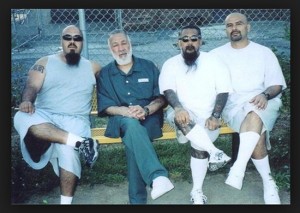SANTA ANA, CALIF.
A longtime member of the Mexican Mafia prison gang who controlled Latino street gangs in Orange County for at least three decades was sentenced today to 15 years in federal prison after being found guilty earlier this year of federal racketeering offenses, officials said.
U.S. District Judge James V. Selna said Peter Ojeda, 74, still represented a “danger to the community.”

A federal jury in January found Ojeda guilty of two offenses: conspiracy to violate the Racketeer Influenced and Corrupt Organizations Act or RICO and conspiracy to commit violent crimes in aid of racketeering.
The jury found that Ojeda ordered murders and assaults while incarcerated in federal prison for a prior racketeering conviction.
Ojeda, who is also known as “Sana” and “The Big Homie,” has been in federal custody since he was indicted in the prior racketeering case in 2005.
“Ojeda is a career criminal and a Mexican Mafia leader, which means he is intimately familiar with the violence, drug trafficking, and extortion that fuels this criminal organization,” said U.S. Attorney Eileen M. Decker. “Prior criminal cases against Mr. Ojeda have not had any deterrent effect, but today’s sentence makes it unlikely that Mr. Ojeda will ever be able to walk freely on the streets where his criminal organization has caused so much harm.”
Ojeda was convicted by a jury that heard evidence during a two and half month trial before the United States District Court in Santa Ana. The jury found that both conspiracies involved plots to murder other gangsters as part of a turf war with a rival Mexican Mafia member who attempted to assert control over local street gangs after Ojeda was imprisoned in his prior case.
In relation to the RICO conspiracy, the jury found that Ojeda was involved in the operation and management of the Mexican Mafia’s activities in Orange County, which included conspiring to commit murder, extortion, and narcotics trafficking.
Ojeda ordered Latino street gangs in Orange County to pay “taxes” that consisted of a portion of the proceeds the gangs earned from various  criminal activities, including drug trafficking. In return, gang members were permitted to exert influence over their neighborhoods and territories and seek protection or assistance from the Mexican Mafia.
criminal activities, including drug trafficking. In return, gang members were permitted to exert influence over their neighborhoods and territories and seek protection or assistance from the Mexican Mafia.
Ojeda’s girlfriend, Suzie Rodriguez, 53, was also found guilty in the RICO and VICAR conspiracies for acting as a messenger between Ojeda and local gang leaders while
Ojeda was housed in a federal prison in Pennsylvania.
During the trial, prosecutors argued that Rodriguez acted as Ojeda’s eyes, ears, and voice on the streets of Orange County. Judge Selna is scheduled to sentence Rodriguez on June 6, 2016.
The Mexican Mafia is a powerful and violent prison gang that controls drug distribution and other illegal activities within the California penal system and on the streets of Southern California by organizing Latino street gang members for the purpose of establishing a larger network for the Mexican Mafia’s illegal activities. If a street gang does not comply with the demands of the Mexican Mafia, the prison gang will order the assault or murder the offending gang’s members, whether they are in custody or on the streets.
In the prior federal case, Ojeda pleaded guilty to conspiring to violate RICO and conspiring to distribute narcotics.
In late 2006, he was sentenced to 14 years in federal prison. It was while in federal prison that he participated in the subsequent conspiracy that led to his indictment, conviction, and today’s sentencing.
Ojeda’s conviction was the result of Operation “Black Flag,” an investigation conducted by the Santa Ana Gang Task Force.
As a result of the investigation, 59 defendants were convicted on federal charges, and another 40 defendants were prosecuted by the Orange County District Attorney’s Office.
The Santa Ana Gang Task Force is made up of agents and officers with the Federal Bureau of Investigation; the Santa Ana Police Department; the Orange County Sheriff’s Department; the Bureau of Alcohol, Tobacco and Firearms and Explosives; and the California Department of Corrections and Rehabilitation.
The Anaheim Police Department, the Los Angeles Sheriff’s Department and the U.S. Bureau of Prisons provided substantial assistance.

